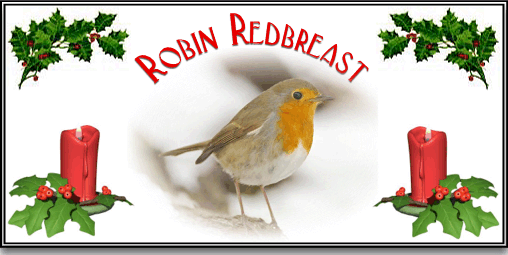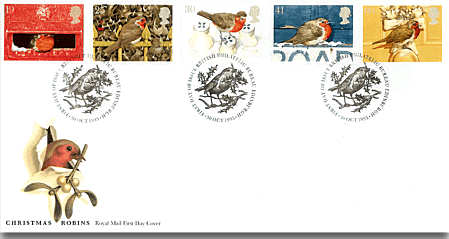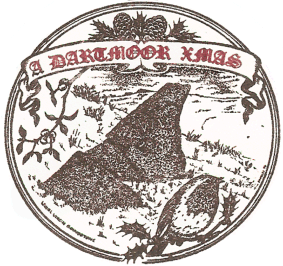
“A dog is for life, not Christmas”, is a well known saying and similarly you could say, “A robin is all year, not just Christmas”. Walk through a wood on a cold, dank and drear winter’s day and the chances are that somewhere ‘Robin Redbreast’ will be optimistically trilling away from some bush. The bird has become synonymous with Christmas and as soon as the cards start dropping on the doormat they reveal pictures of the robin amidst various snow scenes and winter greenery.
Erithacus rubecula or the robin can be found ranging far and wide on Dartmoor, from the plantations and broad leafed woodlands to farmland and gardens. One study in the Postbridge area suggested that around about the 1950’s and 60’s there were between 100 and 150 breeding pairs. The harsh winter of 1963 cut their numbers dramatically to roughly 50 – 60 breeding pairs. Luckily the population has slowly increased over the past 30 years with a similar picture across the whole of the moor. It is also thought that in addition to the native populations there are also winter migrants visiting towards the end of the year. It could well be this sudden boost in winter numbers that has contributed to the Christmas association along with December coinciding with their search for a mate.
Despite its size and endearing appearance the robin is one of the most aggressive birds as far as defending their territories is concerned. How often have you heard the angry chattering and seen robin chasing a rival away? It is not only other invading robins that get the rough treatment, any straying bird will become the target for their spleen. The average size for a robin is around 5cm and their diet consists of worms, insects and seeds. The breeding season starts in mid winter when a female bird will come into a male’s territory, probably attracted by its song. Come March the pair will have built their nest, often lined with moss or hair and the female will lay her first clutch of eggs. It’s at this time that the males will vigorously defend their territories. It takes about two to three weeks for the youngsters to fledge after which time they will fly off to find their own territories. The female will then lay anything up to a further four clutches of eggs throughout the coming weeks. At first the youngsters have no red breasts probably because it acts as a sign of aggression to other robins and they aren’t big or strong enough to defend themselves. I think the song of the robin is one of the most melodic and heart warming of all the birds and it has the distinction of being heard all year round. Their song is one of the earliest of the dawn chorus and can also be heard at night, especially near street lights which has led to it being mistaken for a nightingale.
The robin features highly in the lore and traditions of the moor and has done so for centuries, the old Devonshire name for a robin was “Rabbin urdick”. This more than likely comes from a dialect corruption of the Anglo Saxon word ruddoc which was a robin and later became ruddick. On Dartmoor there is a Raddick Hill, plantation, lane and gate and my personal theory is that the name ‘Raddick‘ came from ruddick thus giving the robin’s hill etc.
Ok, let’s start with its colouration, originally the bird’s plumage was completely brown, that is until the day of Jesus’ crucifixion. It was on this day that the robin alighted on his shoulder to softly sing in his ear in the hope that it would relieve some of the pain he was suffering. Whilst doing this some of Jesus’ blood stained the little birds chest and since that day all the robins have red breasts in memory of that one kind act. Other versions are that it got its redbreast when it pulled the thorns out of Jesus’ crown and the blood stained its chest or that the chest got singed red when a robin took water to the souls in hell. It may well be this holy association that has led to the belief that bad luck will befall anyone who kills a robin. A well known saying is:
“Robin Redbreast and Jenny Wren
Are God’s Almighty’s cock and hen“.
On the moor it is still considered a bad omen, usually of of death, if a robin enters the house especially if it makes a “teep”, “teep”, call. With the advent of the Christmas card this belief was taken further in-so-much as it was thought that any card that portrayed a robin was bad luck. I can remember granny always saying that if anybody sent a card with a robin they were no friend as they were wishing you bad luck, she would immediately tear up any such card. I also have known her send a few to people she disliked. I think it was a good job that the old dear wasn’t alive in 1995 because as can be seen from the picture below every Christmas stamp that year showed a robin, I would imagine that all the post for a good month would have been binned immediately. This first day cover would have freaked her beyond all comprehension, in fact she would probably have taken to her bed in preparation for the impending ‘long sleep’.

One theory as to why many robins on Christmas cards carry letters in their beaks is that at one time all the postmen wore red waistcoats and were known as ‘Robins’. In fact it was only in 1952 that the British Trust for Ornithology officially changed the bird name to ‘robin’, up until then it was always known as ‘robin redbreast’. The other tradition associated with the pagan Yule festival is that the eternal circle of the year ends with the battle of the holly king, represented by the wren and the oak king represented by the robin. In this battle the wren or old year is defeated and killed by the new year or robin and the cycle starts again. Once again this belief could be another reason the robin has become associated with the Christian festival of Christmas and appears on Christmas Cards.
If anybody dared to steal an egg from a robin’s nest the penalty would be that all the milk produced in the area would be discoloured. Another Dartmoor superstition goes that if anybody took a robin’s nest then all the ‘clomb’ (crockery) in the house would break. If a robin was ever seen to hop over the threshold of a door then it was an omen of a forthcoming debt. But in some areas it was considered lucky should a robin enter the house in the month of November. On seeing the first robin of the new year it was said that any wish made would come true, if however the bird flew away before the wish was finished this would end up with 12 month’s bad luck. The robin has also been used to forecast the weather, if it is heard singing from cover then bad weather is on the way, conversely if the robin sings from an open branch then good weather is coming. I have also heard tell that if a robin ever finds a dead body it will cover the corpse’s face with moss and leaves as a mark of its love for the human race. This tradition may well come from the story of ‘The Babes in the Wood’ as it was a robin that covered the faces of the dead ‘babes’. Although I know of no example on Dartmoor, you can sometimes see a robin carved on gravestones possibly denoting that the deceased was a friendly person.
On Dartmoor it is not only on Christmas cards that the robin appears, the letterboxing tradition of Christmas stamps has now meant that they often feature in the festive letterbox stamps that are put on the moor or taken to the meets.

A Christmas letterbox stamp.
 Legendary Dartmoor The many aspects past and present of Dartmoor
Legendary Dartmoor The many aspects past and present of Dartmoor

so it is bad luck to get a card with a robin on it
?